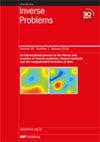Structured model selection via ℓ1−ℓ2 optimization
IF 2
2区 数学
Q1 MATHEMATICS, APPLIED
引用次数: 0
Abstract
Automated model selection is an important application in science and engineering. In this work, we develop a learning approach for identifying structured dynamical systems from undersampled and noisy spatiotemporal data. The learning is performed by a sparse least-squares fitting over a large set of candidate functions via a nonconvex通过 ℓ1-ℓ2 优化进行结构化模型选择
自动模型选择是科学和工程领域的一项重要应用。在这项工作中,我们开发了一种学习方法,用于从采样不足和噪声较大的时空数据中识别结构化动力系统。学习是通过对大量候选函数集进行稀疏最小二乘拟合来完成的,该拟合是通过非凸 ℓ1-ℓ2 稀疏优化法进行的,该优化法由乘数交替方向法求解。我们证明,如果候选函数集构成了有界正交系统的结构化随机抽样矩阵,则恢复是稳定的,误差也是有界的。学习方法在粘性布尔格斯方程和两个反应扩散方程生成的合成数据上得到了验证。计算结果证明了理论上的成功保证以及与候选函数数量相关的效率。
本文章由计算机程序翻译,如有差异,请以英文原文为准。
求助全文
约1分钟内获得全文
求助全文
来源期刊

Inverse Problems
数学-物理:数学物理
CiteScore
4.40
自引率
14.30%
发文量
115
审稿时长
2.3 months
期刊介绍:
An interdisciplinary journal combining mathematical and experimental papers on inverse problems with theoretical, numerical and practical approaches to their solution.
As well as applied mathematicians, physical scientists and engineers, the readership includes those working in geophysics, radar, optics, biology, acoustics, communication theory, signal processing and imaging, among others.
The emphasis is on publishing original contributions to methods of solving mathematical, physical and applied problems. To be publishable in this journal, papers must meet the highest standards of scientific quality, contain significant and original new science and should present substantial advancement in the field. Due to the broad scope of the journal, we require that authors provide sufficient introductory material to appeal to the wide readership and that articles which are not explicitly applied include a discussion of possible applications.
 求助内容:
求助内容: 应助结果提醒方式:
应助结果提醒方式:


